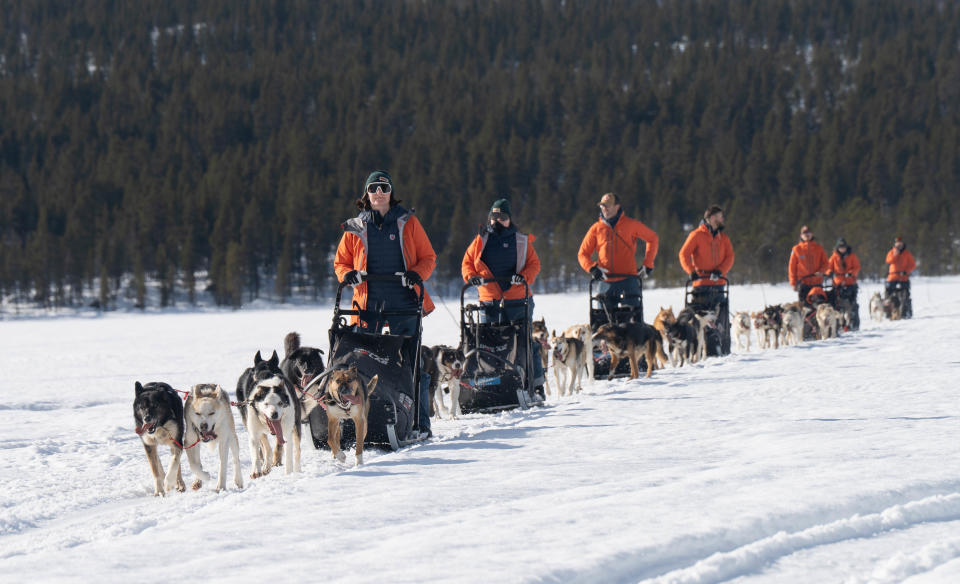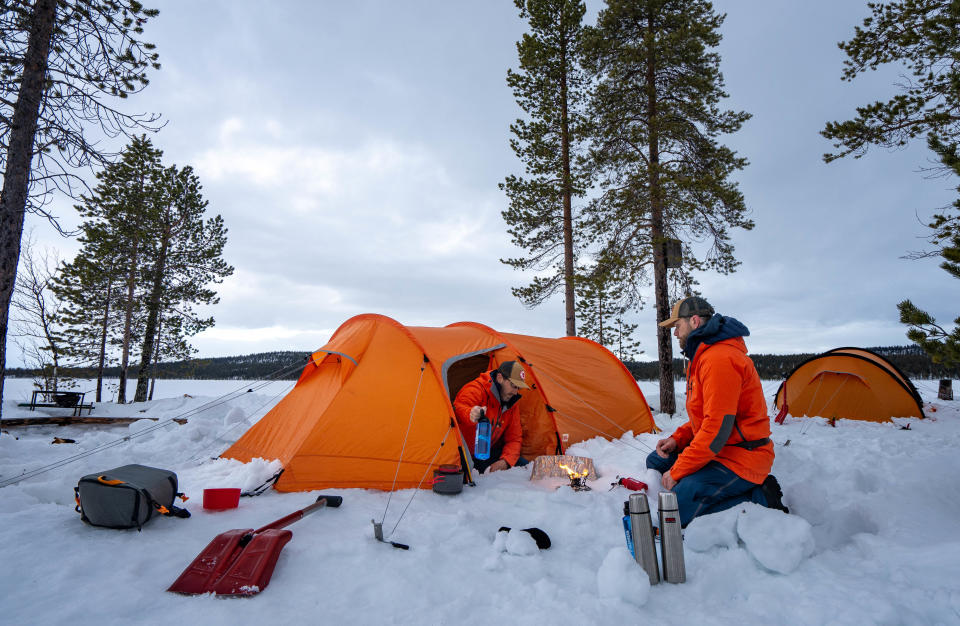Chasing Adventure on a Dog Sledding Trip Through Swedish Lapland

Maskot/Getty
This is part of Travel Firsts, a series featuring trips that required a leap of faith or marked a major life milestone.
Five ecstatic huskies are pulling me through an icy white landscape, tongues lolling out of their mouths and legs pumping like pistons. Technically I’m driving a dog-powered rig, but my speeding, wedge-shaped sled feels more like a 300-horsepower sports car. As the four-legged engines strain to go faster, I press my foot onto the studded metal plate that serves as a brake, trying to slow their cadence.
It's hard to believe that I’m in Swedish Lapland, some 120 miles above the Arctic Circle, mushing a team through hushed, snow-covered forests and over frozen lakes. I live in Texas, after all, where we’re used to horses and heatwaves but can barely drive pickup trucks in sleet.
Fueled by a reindeer-and-cheese sandwich and wearing a parka trimmed in fake fur, I’m fulfilling a life-long dream. Growing up, I loved the story of Balto, the dog that famously pulled a sled loaded with medicine to Nome, Alaska, preventing a diphtheria outbreak in 1925. I have since fantasized about gliding through a chilly, blue-white landscape behind a team of yipping huskies like him.
I'm in my late 50s, and this trip is my way of saying I’m nowhere near ready to give up on adventuring.
The way I got here was a bit of a dream as well: Each year, the Swedish outdoor company Fjallraven hosts a free, 5-day trip for 20 adventure-loving people, chosen from thousands of applicants who send in videos. I was one of several journalists invited on a 3-day, 2-night version of the experience. The goal of the trip is to show that regular people can experience extraordinary adventures, given the right instruction and gear—but in my late 50s, I'm a good 30 years older than most of the people in my group. I've always loved pushing myself outdoors, whether it's backpacking, scuba diving, or paddling, so joining this trip is also my way of saying I’m nowhere near ready to give up on adventuring.

Our group begins the journey by flying from Stockholm to Kiruna, in the far north of the country. From there it's a 20 minute-drive to the Fjellborg kennels, where we met our canine teammates, who are instantly howling with excitement. After some basic instruction by our guides—for example, “don’t let go of the sled”—we released our “anchors,” which are hand-sized metal claws set in the snow to stop the dogs from dashing off before their musher is ready. Once unleashed, I was off: Alone on a sled, driving a team of five dogs on a path beneath skies the color of dryer lint.
The first day is easy, with wide trails and gentle hills. We pass a farm where a woman in a red plaid jacket is feeding plump horses, each bundled in a colorful blanket. We dip in and out of trees, then break onto a frozen lake, following a row of saplings drilled into the ice that mark the route. My dogs—Anna, Mocha, Evonne, Enis, and Ganter—speed along, chasing the lead team. All I can hear is their panting and the scraping of sleds on ice.
When the sky starts spitting wet, dime-sized clumps of snow about two hours later, we're forced to modify our plans and set up our campsite early. We stop on the banks of Lake Vakkara, close to Vakkara Lodge, where we’ll stay for our second night. There, our guides show us how to use snowshoes to stamp out the ground and make camp. We unfurl our lightweight tunnel-shaped shelters, stake them in the snow, slide in support poles, and pop up what looks like a series of giant, orange caterpillars in the expanse of white. Tucked inside my sleeping bag that night, I listen to the dogs barking from atop their piles of straw, where they are bedded down a few hundred yards away under the stars. I feel so far from everything I know, in the most exciting way.
New challenges await: The next day on the snow, we tackle narrower, trickier trails through towering spruce and pines, with the occasional reindeer dashing across the trail in front of us. You’re supposed to lean into turns to steer the sleds, but I haven’t mastered the skill yet—so I hit trees three separate times with a jolt; once, a collision flips my sled over completely and I struggle to right it, as the dogs stop and peer back at me, obviously annoyed. By the time we stop for lunch, sitting in trenches our guides have dug to protect us from the wind, I am so satisfied with the freeze-dried spaghetti we're eating—nothing has ever tasted so good.

At the end of the second day, we’ve clocked over 30 miles, and I’ve learned a lot about the athletic, double-coated dogs doing all the work. They’ve got unending pools of energy. They can grab mouthfuls of snow to hydrate, while barely slowing their gait. They can poop on the run (an impressive but odiferous skill that involves bounding on two legs for a few strides and, regrettably, some flying missiles). They eat twice a day, inhaling buckets of raw meat, goopy-looking, high-calorie fat, and kibble that the guides carry on their sleds. Thick ointment helps keep their foot pads supple; some of them wear booties for extra protection. (“They’re like marathon runners,” says musher Melanie Sommerfeldt with Fjellborg, who is leading me and four other sleds.) They are always happy to see us.
In uphill stretches, we take one foot off the sled's runners and help the dogs push. On downhill sections it takes all my strength to clamp down on the brake. It's tiring work, and I feel like a champ by the time we slide up to the lodge on our last night. We've all made it through. As is now our routine, we unharness the dogs, showering them with pets and snuggles, and thank them for their effort. Then we head to the “pool”—a table-sized hole cut in the ice, where we can ease into the slushy waters of the lake—for a cold plunge that leaves me tingly and pink, before we sprint to the sauna. By the time we tuck into our cozy, heated cabins, I already miss the wonder of the days out in the snow. Life, it seems, is better at a dog’s pace.
Originally Appeared on Condé Nast Traveler


